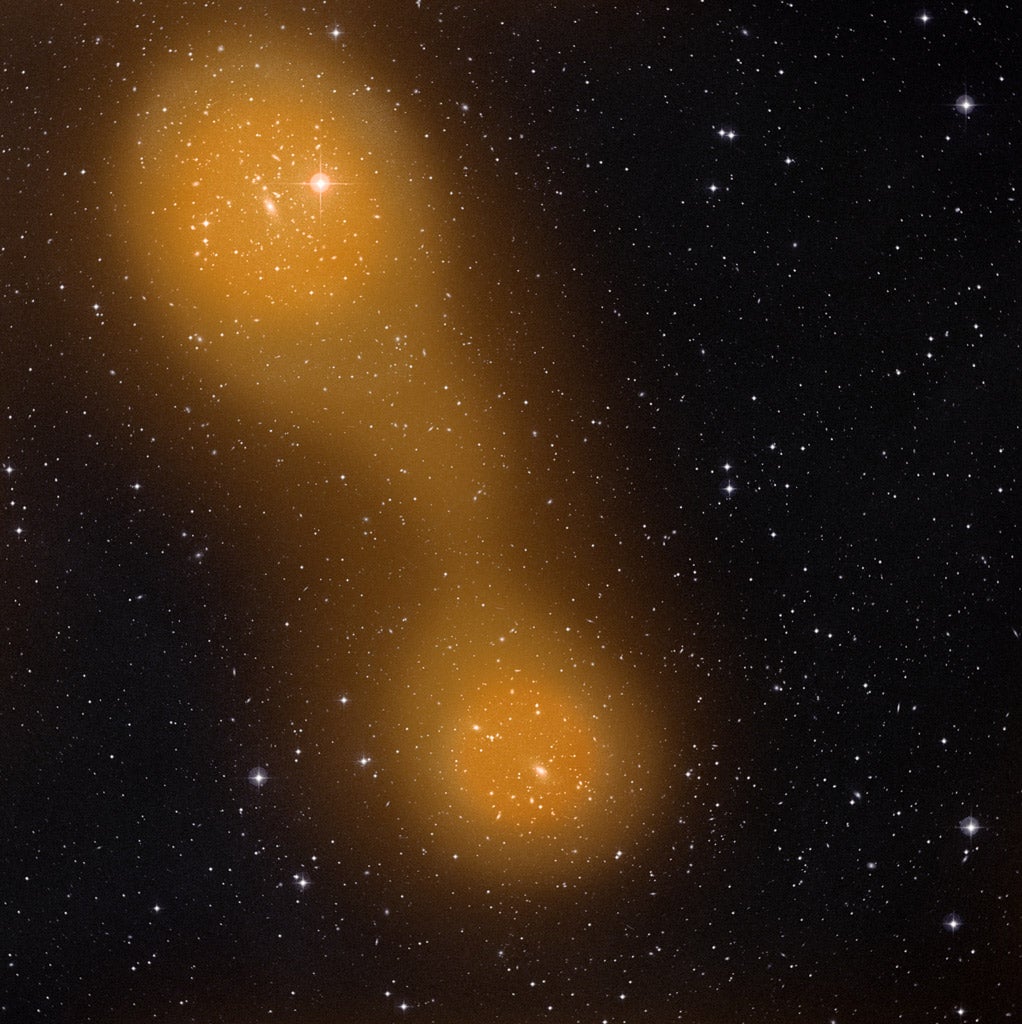Planck’s primary task is to capture the most ancient light of the cosmos, the cosmic microwave background (CMB). As this faint light traverses the universe, it encounters different types of structures, including galaxies and galaxy clusters — groups of hundreds to thousands of galaxies bound together by gravity.
If the CMB light interacts with the electrons in hot gas, it receives a boost in energy, a phenomenon known as the Sunyaev–Zel’dovich (SZ) effect. By finding places in space where the CMB light has higher energy, astronomers can determine where it interacted with hot gas and, thus, where cosmic structures are.
Scientists already have used Planck and the SZ effect to detect galaxy clusters, but the telescope also provides a way for them to detect faint filaments of gas that might connect one cluster to another.
In the early universe, threads of gaseous matter pervaded the cosmos in a giant web, and galaxy clusters eventually formed at the web’s densest nodes.
Much of this tenuous, stringy gas remains undetected, but astronomers expected that it would be brightest between interacting galaxy clusters, where the filaments are compressed and heated up.
Planck’s discovery of a bridge of hot gas connecting the clusters Abell 399 and Abell 401, each containing hundreds of galaxies, proved the idea correct.
While X-ray data from ESA’s XMM-Newton first hinted at the presence of hot gas between the billion-light-year-distant clusters, the new Planck data confirm the observation.
This is Planck’s first detection of intercluster gas using the SZ effect.
By combining the Planck data with archival X-ray observations from the German satellite Rosat, astronomers found that the gas in the bridge is approximately the same temperature as the gas in the two clusters — about 140 million degrees Fahrenheit (80 million degrees Celsius).
Early analysis suggests that the gas could be a mixture of cosmic web gas and gas originating from the clusters.
A more detailed analysis and the possible detection of gas bridges connecting other clusters will help to provide a more conclusive answer.
The new finding highlights Planck’s ability to probe the outskirts of galaxy clusters and beyond, examining their connection with the primordial gas from which all groups of galaxies formed.
Planck’s primary task is to capture the most ancient light of the cosmos, the cosmic microwave background (CMB). As this faint light traverses the universe, it encounters different types of structures, including galaxies and galaxy clusters — groups of hundreds to thousands of galaxies bound together by gravity.
If the CMB light interacts with the electrons in hot gas, it receives a boost in energy, a phenomenon known as the Sunyaev–Zel’dovich (SZ) effect. By finding places in space where the CMB light has higher energy, astronomers can determine where it interacted with hot gas and, thus, where cosmic structures are.
Scientists already have used Planck and the SZ effect to detect galaxy clusters, but the telescope also provides a way for them to detect faint filaments of gas that might connect one cluster to another.
In the early universe, threads of gaseous matter pervaded the cosmos in a giant web, and galaxy clusters eventually formed at the web’s densest nodes.
Much of this tenuous, stringy gas remains undetected, but astronomers expected that it would be brightest between interacting galaxy clusters, where the filaments are compressed and heated up.
Planck’s discovery of a bridge of hot gas connecting the clusters Abell 399 and Abell 401, each containing hundreds of galaxies, proved the idea correct.
While X-ray data from ESA’s XMM-Newton first hinted at the presence of hot gas between the billion-light-year-distant clusters, the new Planck data confirm the observation.
This is Planck’s first detection of intercluster gas using the SZ effect.
By combining the Planck data with archival X-ray observations from the German satellite Rosat, astronomers found that the gas in the bridge is approximately the same temperature as the gas in the two clusters — about 140 million degrees Fahrenheit (80 million degrees Celsius).
Early analysis suggests that the gas could be a mixture of cosmic web gas and gas originating from the clusters.
A more detailed analysis and the possible detection of gas bridges connecting other clusters will help to provide a more conclusive answer.
The new finding highlights Planck’s ability to probe the outskirts of galaxy clusters and beyond, examining their connection with the primordial gas from which all groups of galaxies formed.










